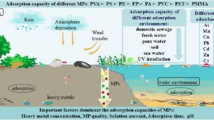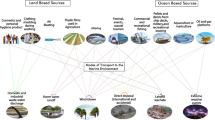Abstract
Nelumbo nucifera Gaertn. (lotus) roots were collected from contaminated sediments which were artificially adding different concentrations of chiral polychlorinated biphenyls (PCBs) to investigate the effect of concentration on the accumulation characteristics and chiral signatures of PCBs in lotus root during its growth period of 150 days. Under high PCB exposure concentration, the biota-sediment accumulation factors (BSAFs) of PCBs 91, 95, and 136 in the lotus root were up to 0.25–0.46 and 8.10–10.5 times higher than those under low-exposure concentration (0.024–0.052). The BSAFs of PCBs 149, 176, and 183 under high-exposure concentration were up to 0.24–0.44, while they were undetected at low concentration. The significant difference observed in the BSAFs based on different concentrations indicates that the lotus root accumulation efficiency toward chiral PCBs increases with the contaminate concentration. Although the (–)-enantiomers of PCBs 91, 95, and 136 were all preferentially accumulated in lotus root under two exposure concentrations, the extent of the preferential accumulation of (–)-PCB 95 decreased with increasing exposure concentration throughout the whole growth period (30–150 days). In addition, the (–)-enantiomers of PCBs 91 and 136 also showed the same tendency during most of the growth period. Conclusively, the exposure concentrations are an important influence factor on the enantioselective accumulation of chiral PCBs in lotus root.



Similar content being viewed by others
Data availability
All data generated or analyzed during this study are included in this published article.
References
Asher BJ, Wong CS, Rodenburg LA (2007) Chiral source apportionment of polychlorinated biphenyls to the Hudson River estuary atmosphere and food web. Environ Sci Technol 41:6163–6169
Chai TT, Cui F, Song Y, Ye LL, Li TT, Qiu J, Liu XQ (2018) Enantioselective toxicity in adult zebrafish (Danio rerio) induced by chiral PCB91 through multiple pathways. Environ Sci Technol 52:5448–5458
Chen SJ, Tian M, Zheng J, Zhu ZC, Luo Y, Luo XJ, Mai BX (2014) Elevated levels of polychlorinated biphenyls in plants, air, and soils at an E-waste site in Southern China and enantioselective biotransformation of Chiral PCBs in plants. Environ Sci Technol 48:3847–3855
Coleman JOD, BlakeKalff MMA, Davies TGE (1997) Detoxification of xenobiotics by plants: chemical modification and vacuolar compartmentation. Trends Plant Sci 2:144–151
Dai S, Wong CS, Qiu J, Wang M, Chai T, Fan L, Yang S (2014) Enantioselective accumulation of chiral polychlorinated biphenyls in lotus plant (Nelumbonucifera spp.). J Hazard Mater 280:612–618
Dai SH, Zhao HL, Wang M, Wong CS, Chai TT, Yang SM, Qiu J (2012) Determination of polychlorinated biphenyl enantiomers in lotus root and sediment by chiral gas chromatography-mass spectrometry. Chin J Anal Chem 40:1758–1762
Desborough J, Harrad S (2011) Chiral signatures show volatilization from soil contributes to polychlorinated biphenyls in grass. Environ Sci Technol 45:7354–7357
Djikanovic V, Skoric S, Spasic S, Naunovic Z, Lenhardt M (2018) Ecological risk assessment for different macrophytes and fish species in reservoirs using biota-sediment accumulation factors as a useful tool. Environ Pollut 241:1167–1174
Harner T, Wiberg K, Norstrom R (2000) Enantiomer fractions are preferred to enantiomer ratios for describing chiral signatures in environmental analysis. Environ Sci Technol 34:218–220
Harrad S, Ren JZ, Hazrati S (2006) Chiral signatures of PCB#s 95 and 149 in indoor air, grass, duplicate diets and human faeces. Chemosphere 63:1368–1376
He ZY, Wang YH, Zhang YW, Cheng HY, Liu XW (2018) Stereoselective bioaccumulation of chiral PCB 91 in earthworm and its metabolomic and lipidomic responses. Environ Pollut 238:421–430
He ZY, Xu YP, Wang WW, Liu XW (2018) Stereoselective bioaccumulation and elimination of chiral PCBs 95 and 149 in earthworm Eisenia fetida. Chemosphere 212:497–503
Kania-Korwel I, Hornbuckle KC, Robertson LW, Lehmler HJ (2008) Dose-dependent enantiomeric enrichment of 2,2′,3,3′,6,6′-hexachlorobiphenyl in female mice. Environ Toxicol Chem 27:299–305
Kania-Korwel I, Lehmler HJ (2013) Assigning atropisomer elution orders using atropisomerically enriched polychlorinated biphenyl fractions generated by microsomal metabolism. J Chromatogr A 1278:133–144
Kania-Korwel I, Lehmler HJ (2016) Chiral polychlorinated biphenyls: absorption, metabolism and excretion-a review. Environ Sci Pollut R 23:2042–2057
Kania-Korwel I, Lukasiewicz T, Barnhart CD, Stamou M, Chung H, Kelly KM, Bandiera S, Lein PJ, Lehmler HJ (2017) Editor's highlight: congener-specific disposition of chiral polychlorinated biphenyls in lactating mice and their offspring: implications for PCB developmental neurotoxicity. Toxicol Sci 158:101–115
Lehmler HJ, Harrad SJ, Huhnerfuss H, Kania-Korwel I, Lee CM, Lu Z, Wong CS (2010) Chiral polychlorinated biphenyl transport, metabolism, and distribution: a review. Environ Sci Technol 44:2757–2766
Li XS, Wu XN, Kelly KM, Veng-Pedersen P, Lehmler HJ (2019) Toxicokinetics of Chiral PCB 136 and its hydroxylated metabolites in mice with a liver-specific deletion of cytochrome P450 reductase. Chem Res Toxicol 32:727–736
Lu Z, Wong CS (2011) Factors affecting phase I stereoselective biotransformation of chiral polychlorinated biphenyls by rat cytochrome P-450 2B1 isozyme. Environ Sci Technol 45:8298–8305
Ross MS, Verreault J, Letcher RJ, Gabrielsen GW, Wong CS (2008) Chiral organochlorine contaminants in blood and eggs of glaucous gulls (Larus hyperboreus) from the Norwegian Arctic. Environ Sci Technol 42:7181–7186
Sandermann H (1994) Higher-plant metabolism of xenobiotics – the green liver concept. Pharmacogenetics 4:225–241
Wong CS, Garrison AW, Smith PD, Foreman WT (2001) Enantiomeric composition of chiral polychlorinated biphenyl atropisomers in aquatic and riparian biota. Environ Sci Technol 35:2448–2454
Wong CS, Mabury SA, Whittle DM, Backus SM, Teixeira C, DeVault DS, Bronte CR, Muir DCG (2004) Organochlorine compounds in Lake Superior: chiral polychlorinated biphenyls and biotransformation in the aquatic food web. Environ Sci Technol 38:84–92
Zhai GS, Hu DF, Lehmler HJ, Schnoor JL (2011) Enantioselective biotransformation of chiral PCBs in whole poplar plants. Environ Sci Technol 45:2308–2316
Zhang Y, Luo XJ, Mo L, Wu JP, Mai BX, Peng YH (2015) Bioaccumulation and translocation of polyhalogenated compounds in rice (Oryza sativa L.) planted in paddy soil collected from an electronic waste recycling site, South China. Chemosphere 137:25–32
Zheng XB, Luo XJ, Zeng YH, Wu JP, Mai BX (2015) Chiral polychlorinated biphenyls (PCBs) in bioaccumulation, maternal transfer, and embryo development of chicken. Environ Sci Technol 49:785–791
Zheng J, Yan X, Chen SJ, Peng XW, Hu GC, Chen KH, Luo XJ, Mai BX, Yang ZY (2013) Polychlorinated biphenyls in human hair at an e-waste site in China: composition profiles and chiral signatures in comparison to dust. Environ Int 54:128–133
Zheng J, Yu LH, Chen SJ, Hu GC, Chen KH, Yan X, Luo XJ, Zhang SK, Yu YJ, Yang ZY, Mai BX (2016) Polychlorinated biphenyls (PCBs) in human hair and serum from E-waste recycling workers in Southern China: concentrations, chiral signatures, correlations, and source identification. Environ Sci Technol 50:1579–1586
Acknowledgments
We thank the anonymous referees for reviewing this manuscript.
Funding
This work is financially supported by the National Natural Science Foundation of China (No. 20907073 and No. 41807359).
Author information
Authors and Affiliations
Contributions
Shouhui Dai: conducted experimental verification, analyzed the data, and wrote the manuscript.
Jing Qiu: contributed to the research idea and designed the study.
Min Wang: contributed to the conception of the study.
Corresponding author
Ethics declarations
This manuscript has not been published and is not under consideration for publication elsewhere. All the authors have read the manuscript and have approved this submission.
Conflict of interest
The authors declare that they have no conflict of interest.
Ethical approval
Not applicable.
Consent to participate
Not applicable.
Consent to publish
Not applicable.
Additional information
Responsible Editor: Elena Maestri
Publisher’s note
Springer Nature remains neutral with regard to jurisdictional claims in published maps and institutional affiliations.
Rights and permissions
About this article
Cite this article
Dai, S., Qiu, J. & Wang, M. Concentration-dependent enantioselective accumulation of chiral polychlorinated biphenyls in Nelumbo nucifera Gaertn. root from contaminative sediment. Environ Sci Pollut Res 28, 27878–27884 (2021). https://doi.org/10.1007/s11356-021-12530-8
Received:
Accepted:
Published:
Issue Date:
DOI: https://doi.org/10.1007/s11356-021-12530-8




